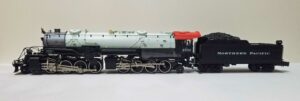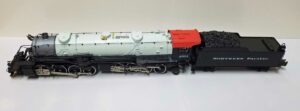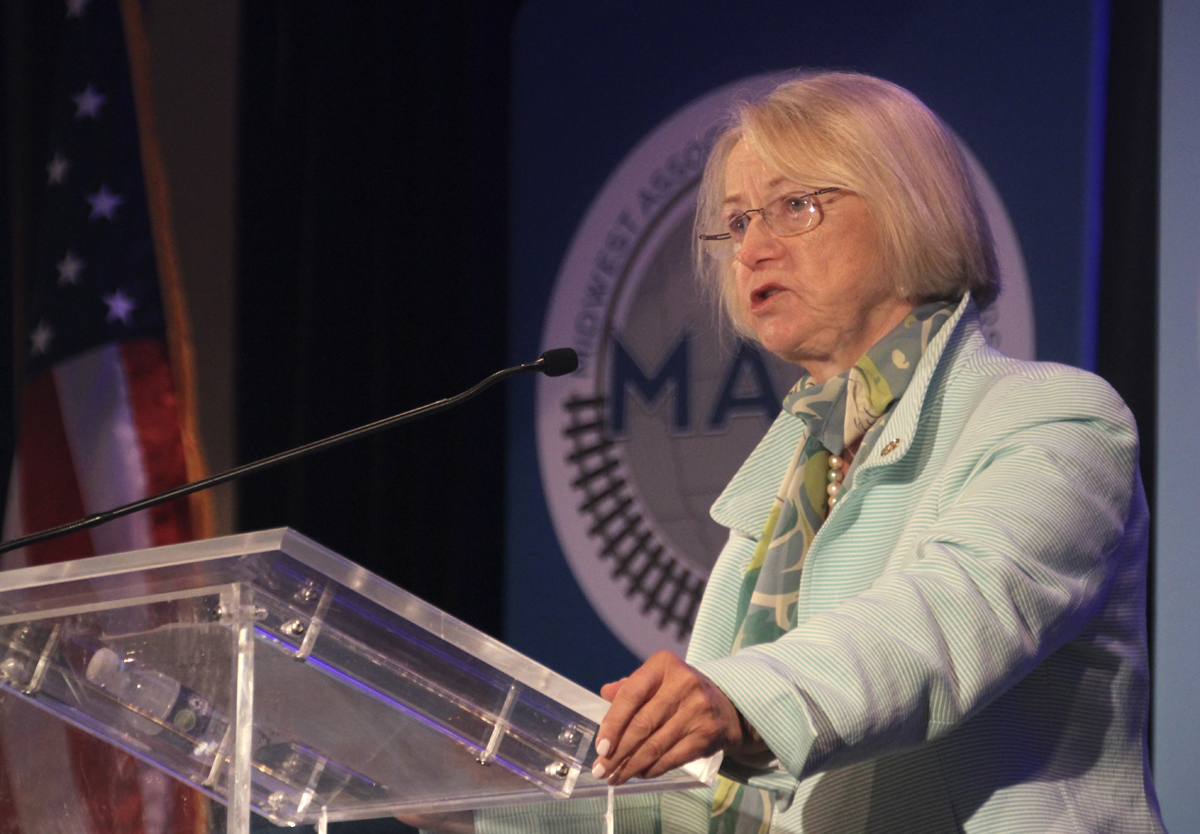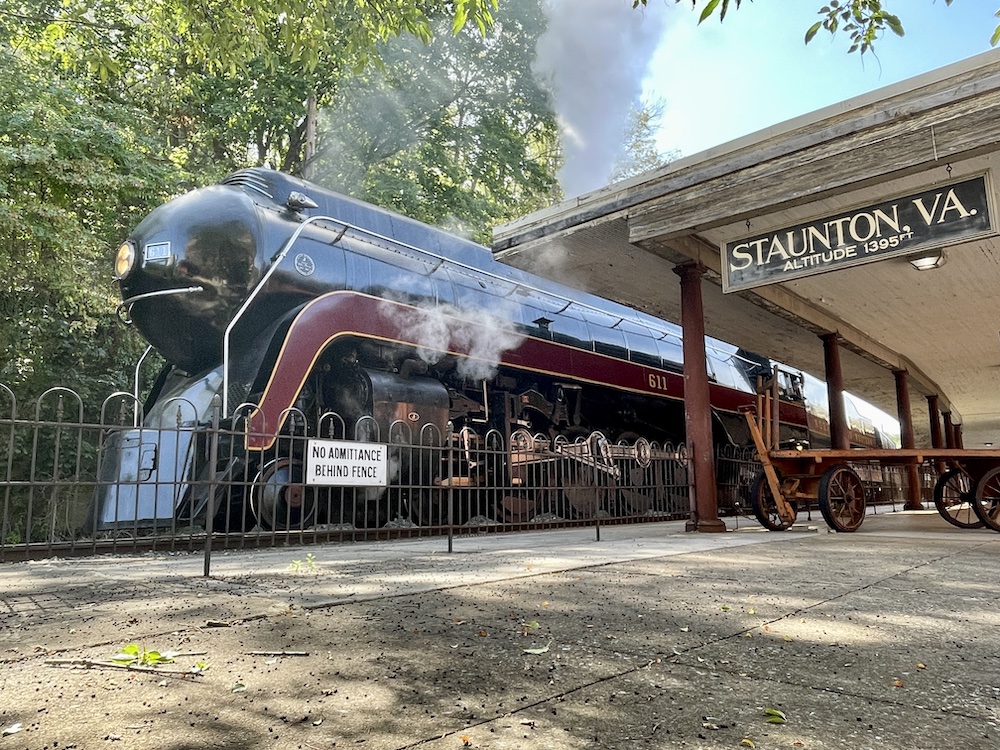The American Flyer Legacy 2-8-8-2 by Lionel was first cataloged in S gauge in 2012. The current offering appeared in the 2022 catalog. This time around the train maker is offering locomotives decorated for Norfolk & Western, Santa Fe, Clinchfield, Baltimore & Ohio, Virginian, Denver & Rio Grande Western, Union Pacific, Pennsylvania, and Northern Pacific.
This release also includes 4- or 6-wheel truck tenders. The B&O, Clinchfield, Virginian, Rio Grande, and Northern Pacific models get the former; the rest sport the latter. The 4-wheel tender is the same one released with the Legacy Pacifics last year. In doing some research, there are photos of actual engines using both tender types.
The American Flyer Legacy 2-8-8-2 by Lionel

When I first opened the box and placed it on my work table I was surprised with the locomotive’s mass. This sent me to my computer and books about steam engines to look up the prototype’s statistics.
There were several variations of the 2-8-8-2, originally a United States Railway Administration design. It was a real puller for the long coal trains of the Norfolk & Western, which heavily influenced the USRA standard. Check out a profile of these engines here.
The Y-3 was the locomotive’s class in N&W nomenclature and perhaps the best-known model. In fact, each railroad that owned these had its own 2-8-8-2 class name. For example, on the Virginian, USRA versions were USA and copies USB; on the Clinchfield they were L-2 and L-3. NP only rostered copies; the example in this review is classed Z-4.
Curious about how steam engines work?
Lots to like
The features of this locomotive include Legacy control system, Digital Command Control, fan-driven smoke, Whistle Steam, directional LED lighting, Electrocoupler on tender, illuminated cab, firebox flicker and ashpan glow, and engineer and fireman figures in the cab.
It can be operated with D.C., but some features like the smoke unit will not work. One feature it doesn’t share with O gauge Legacy engines is Bluetooth control. I’ve gotten very used to using this with the LionChief app and my FlyerChief engines. I miss this feature. On the other hand, this is the first Flyer locomotive that is Whistle Steam-equipped.
In the box with the locomotive and tender are four extra traction tires, a special wrench for the nuts on the main drivers, a funnel and dropper for smoke fluid, and the operations manual.
When the Y-3 and other 2-8-8-2s came out in 2012 some operators converted the engines to scale models by changing the wheels and coupler. This release includes parts to remove the existing coupler and add an included scale version. However, the manual doesn’t give the directions to make the change.
The instructions do, however, explain the use of DCC with the engine far better than earlier versions.
On the rails

First, I ran the NP Z-4 2-8-8-2 with my Flyer 30B transformer only to see how it did. It ran well with quick responses and there were no issues. I have to two Lionel 6-5906 sound activation buttons wired into my layout to control whistle and bell in “Flyonel” engines. Railsounds worked perfectly and the buttons activated the whistle and bell. To get crew talk you have to activate it with a short blast of the whistle; it worked as advertised.
Next, I programmed the locomotive to my Legacy unit and ran it through a series of tests. It did everything as prescribed. I especially appreciated the smoke unit as it was very productive even set at mid-level. The Whistle Steam feature, which gives a smoke release from the whistle when it’s activated, is a real treat! Every one of the people that saw it operate gave a big smile when the “steam” shot out with the sound.
My layout uses original American Flyer track and switches, which means that there are tight curves and Gilbert switch issues that can occur when testing. The Z-4 had no trouble with the curves and went back and forth through the switches without difficulty.
Pulls like the prototype
I tested its pulling ability by placing Gilbert-era Flyer freight cars behind the engine till there was a derailment. The Z-4 was able to pull 22 cars before the weight caused failure. This locomotive is very heavy and has two motors so its ability to pull a toy train on any layout would exceed the needs of almost any modeler.
The appearance of this model is excellent overall. The quite colorful Northern Pacific version has a red cab top, light gray boiler, and a silver or graphite smokebox. It has tons of separately applied handrails and piping. The whistle and bell are brass. The drive wheels have white rims almost like a Gilbert engine.
The engineer and fireman are visible and the cab has lighting when the engine is at rest. There’s also the firebox red glow on this product; it can be seen best during night operations. The NP version has the 4-wheel tender that has a light mounted on the rear top. The light on the 6-wheel tender is inside the rear wall of the tender shell.
The bottom line
When released in 2012, the 2-8-8-2’s price was $999.99. The new release has jumped up to $1,799.99. I reached out to my Lionel contact, Ryan Kunkle, Director of Project Management, to see if he could explain the increase.
He responded by saying the inflation of electronics and labor, the additional cost of including Whistle Steam, and the low production numbers of American Flyer causes them to lose the economies of scale. He added the price of this engine is comparable to similar products in the company’s O gauge line.
My findings for the engine are very positive and I found its operation the same as my 2012 version of the product, which I think is outstanding. The tooling of the 2022 version of the locomotive was the same as the older version. If the market for the Y-3 exists in the future Lionel could choose to produce it again.
My thanks to Ryan for lending me a production example for this review.













